Previously intended mainly for off-grid photovoltaic systems, battery banks are also becoming attractive in installations powered by the electrical grid, mainly for backup purposes (emergency power supply, when there is a grid failure) or for optimizing use. of electrical energy.
Optimizing the use of electrical energy with the help of batteries in grid-connected photovoltaic systems can have different objectives:
- Totally local self-consumption, with the storage of all excess energy from the photovoltaic system (this is what we call “zero export” or “zero grid” operation), avoiding injection into the electricity grid.
- Time shift or displacement in time. This mode of operation consists of storing energy in batteries when it is cheapest, and then using it at times of higher tariffs.
- Peak shaving. This mode of operation is very similar to the previous one, with the exception of the fact that the energy from the batteries will be used to cover consumption peaks. This can be useful, for example, to avoid an increase in contracted demand in facilities that have daily curves with consumption peaks at certain times.
Many manufacturers are currently offering hybrid photovoltaic inverter models, which have inputs for connecting photovoltaic modules and batteries, in addition to incorporating power management and backup functions.
What does it mean to say that a photovoltaic inverter is hybrid? The first answer that comes to mind is the presence of a port for connecting battery banks. The term hybrid, in this case, refers to the inverter's ability to operate simultaneously with a power source (solar panels) and a battery bank.
The second interpretation we can use for the term “hybrid” is the equipment’s ability to operate in two modes: on-grid (or grid-tie) and off-grid.
In on-grid (or grid-tie) mode, the inverter operates as a current source, injecting energy from solar panels or batteries into the electrical grid.
In off-grid mode, the inverter behaves as a voltage source, providing power to the loads connected to its output.
In this second mode of operation, the inverter plays the role of a UPS, which is capable of supplying power from the batteries when no other energy source is available. In the case of an off-grid inverter, unlike a simple UPS, the loads can be supplied simultaneously with energy from batteries and solar panels.
Figure 1 illustrates the two possible operating modes (on-grid and off-grid) of the inverters.
Before we continue, let's make the following parenthesis: the terms on-grid and grid-tie are two synonymous terms found in the literature to refer to the same equipment: the inverter that operates as a current source, connecting to an alternating voltage bus – which can be originated, for example, by the electrical distribution network.
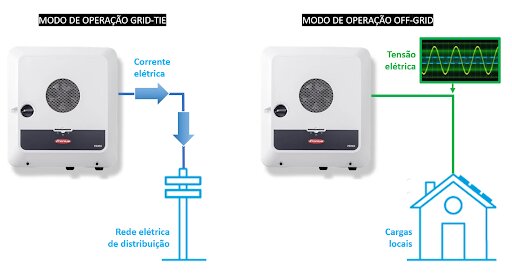
Typically, the so-called “hybrid” inverters that we find on the market have the following characteristics: (1) they have inputs for photovoltaic modules and batteries and (2) they operate in on-grid (grid-tie) and off-grid modes. Therefore, whatever the interpretation given to the term “hybrid”, these devices meet all the criteria to receive this name.
However, not every hybrid inverter is a hybrid. Let me explain: we can find inverters sold as hybrids that have inputs for photovoltaic modules and batteries, but do not have a grid-tie operating mode, that is, they are just off-grid inverters.
Some of these inverters have an AC input port, which allows you to charge the batteries with grid power. Because of this additional AC port, these inverters are sometimes called on-grid. Be very careful here: this is not a grid-tie door. Its function is only to power an internal battery charger.
So these wrongly called hybrid inverters are just off-grid inverters with an AC input port. These inverters can be better defined as inverter chargers. We will talk in more detail about this type of inverter in another article.
More important than defining the name of each inverter is understanding how the equipment works and what features they can offer us.
Inverters can have multiple input and output ports. Each port has a specific function and operates with a flow of energy that can be unidirectional or bidirectional.
The inverters that we can call hybrids have at least two input ports, one of which is bidirectional (for battery operation). Next, the hybrid inverter must have one or more AC ports, with the ability to operate in both on-grid and off-grid modes – with the off-grid mode of operation essentially being used as a backup resource).
Next, we will learn about some types of inverters and analyze how they work according to the number and types of ports each one has.
Standard grid-tie inverter
This inverter has only one DC input port and one AC output port, as seen in Figure 2 below.

In this equipment, the two ports, input and output, are unidirectional. The function of the input port is to receive energy from the solar panels, while the output port is to inject energy into the electrical grid.
Standard off-grid inverter
The standard off-grid inverter has a DC input that receives power from a battery bank (or other DC power source) and provides power in the form of alternating voltage at its output. Also in this case, the two ports are unidirectional, as shown in Figure 3.
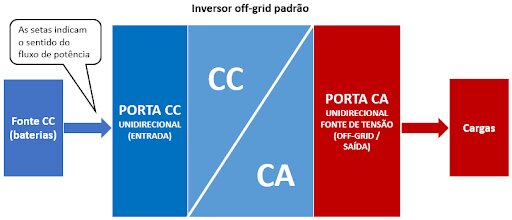
Hybrid inverter
This inverter has at least two input ports: unidirectional (for connecting solar panels) and bidirectional (for connecting batteries). At the output we find a bidirectional AC port (for grid-tie mode) and a unidirectional AC port (for off-grid mode), as shown in Figure 4 below:
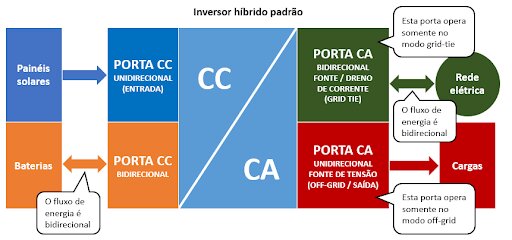
Examples of hybrid grid-tie inverters
Example 1: Growatt SHP 3000-6000
Below we analyze an example of an on/off-grid hybrid inverter found on the market. Figure 5 shows the bottom part of the equipment, where the electrical connections are made. We note the presence of an input for solar panels, an input for batteries and two AC outputs: one for grid-tie operation and the other for off-grid operation.
The equipment illustrated here has exactly the port structure shown in Figure 4. It is a classic example of a hybrid photovoltaic inverter, which operates connected to the electrical grid most of the time (functioning like a conventional grid-tie inverter, in addition to ability to manage the use of energy with batteries), but has the possibility of operating in off-grid mode when there is a grid failure, supplying local loads with its AC output, completely isolated from the electrical grid.
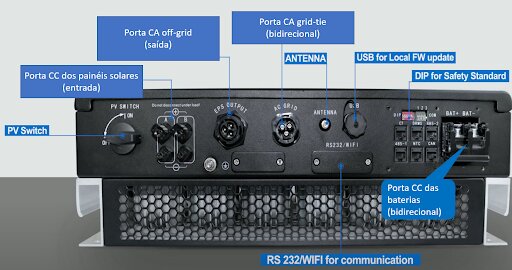
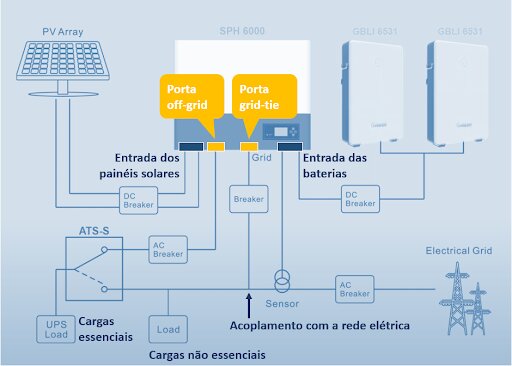
Operating modes
On-grid mode (when the grid is connected)
The equipment works like a hybrid grid-tie inverter, doing everything you expect from an inverter like this: injecting energy into the electrical grid and charging the batteries with solar energy or energy from the grid. Discharges the batteries according to user programming.
According to the manufacturer's manual, different programming is possible within the online operating mode:
Priority for local consumption: This is the equipment's default programming. In this mode of operation, the energy from the solar panels primarily serves local consumption. When solar energy is insufficient, batteries are discharged. If there is excess solar energy, the batteries will be recharged. Lastly, if there is excess solar energy and the batteries are charged, there will be an injection of energy into the electrical grid (unless the “grid zero” function is active.
Priority for charging the batteries: With this programming, the inverter will always charge the batteries first. Once the batteries are charged, the solar energy will be destined for local consumption. The batteries can be charged exclusively with solar energy or charging via the electrical grid can be enabled (“AC grid charging” function).
Priority for the electrical grid: In this third mode of operation, all energy from the solar panels is injected into the electrical grid first. The batteries will be powered last, with surplus energy or also from the electrical grid.
Backup operating mode (off-grid)
When the electrical grid fails, the equipment goes into off-grid mode and the off-grid port starts to supply part of the local loads. Only so-called priority loads (which are chosen by the user) will be connected to this port, respecting the maximum output power of the equipment.
Example 2: Fronius GEN24
A very interesting hybrid inverter is the GEN24 from Fronius, illustrated in Figure 7. The manufacturer defines it as a multifunctional hybrid inverter, which basically has grid-tie and off-grid operating modes, as well as an additional feature called “PV point ”.
In grid-tie mode, the equipment extracts energy from solar panels and/or batteries to supply local consumption, and can prioritize consumption or battery charging, according to the programming made by the user.
In off-grid mode, the inverter works as a voltage source, creating a network to activate priority loads that are connected to the equipment's AC output.
The “PV point” feature, which comes into action in off-grid mode, offers the possibility of powering local loads (with limited power) solely from solar panels, without the need for batteries.
We can find this in the manufacturer's manual (with adaptations):
“The inverter is intended for use in grid-coupled photovoltaic systems. The inverter automatically monitors the public power grid.
After installation and commissioning, the inverter works fully automatically and obtains the maximum possible power from the solar modules.
Depending on the point of operation, this power is used in the home electrical grid, stored in a battery, or exported to the grid.
When the power supply from the solar module is not sufficient, the power from the battery is fed into the domestic electrical grid. Depending on the configuration, it is also possible to use power from the public electricity grid to charge the battery.”
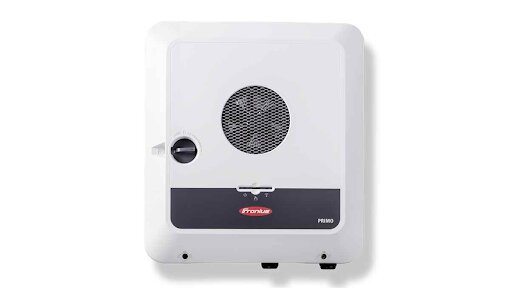
Figure 8 illustrates the power flows that can occur in the different operating modes of the equipment:
- Flow from solar panels to the electrical grid: occurs when the inverter is operating in grid-tie mode and the battery is charged. All energy from solar panels is destined for local consumption (from loads connected to the grid) or is exported to the electrical system – if there is a surplus;
- Flow from solar panels to the battery: occurs when the battery is discharged and there is excess energy generated by the solar panels or charging the batteries is a priority;
- Flow from batteries to local loads or to the electrical grid: occurs when the inverter is in grid-tie mode and has been programmed to perform some energy management function (time shift, for example) or when the inverter is in off-grid mode. grid and energy from solar panels is insufficient to supply the loads;
- Flow from the electrical grid to the batteries: occurs when the inverter is in grid-tie mode and the batteries are being charged with energy from the electrical grid.
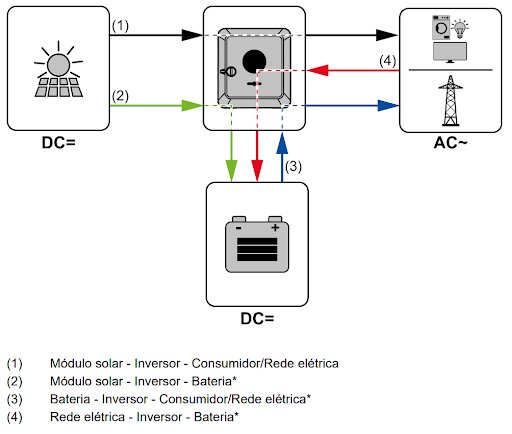
The following figures illustrate how to use the connection ports of the Fronius GEN 24. As with all hybrid inverters, we have a unidirectional port for connecting the solar panels and a bidirectional port for connecting the batteries.
Unlike other hybrid inverters, the Fronius GEN 24 introduces two new features. The first of these is an off-grid port for the “PV point” function, which we commented on previously. This port provides an alternating voltage supply with energy supplied directly from the solar panels, without the use of batteries. This is useful for powering small emergency loads (lighting, for example) if you have the inverter installed without a battery bank (operating as if it were a conventional grid-tie inverter, with the exception of the presence of the “PV point” ).
Another new feature of this equipment is that it has an AC port that, in addition to being bidirectional, is multifunctional. In other words, this is an AC port that can be used in both grid-tie and off-grid operation, as illustrated in Figure 9 below.
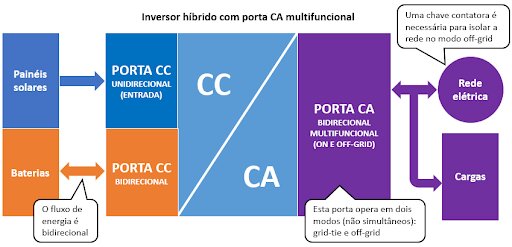
In grid-tie mode, the AC port is connected to the electrical grid and can inject energy (from solar panels or batteries) or can receive energy (to charge the batteries with energy from the electrical grid).
In off-grid mode, when the inverter must operate disconnected from the electrical grid, the AC port provides alternating voltage to supply local loads. For the port to change function (from grid-tie to off-grid), the equipment must be disconnected from the electrical network. This is possible with the use of a contactor switch external to the equipment, as shown in Figures 10 and 11 below.
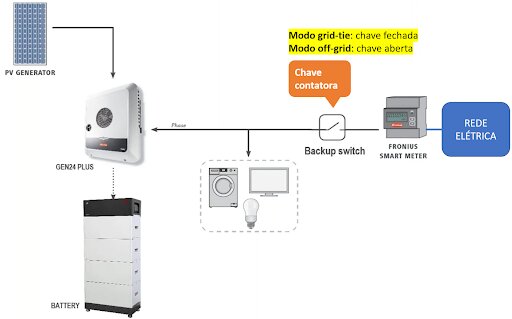
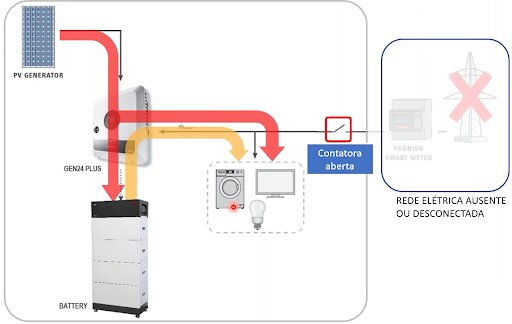
In Figures 12 and 13 we see the input ports for batteries and solar panels, the “PV point” AC output port (purely off-grid) and the multifunctional AC output port.
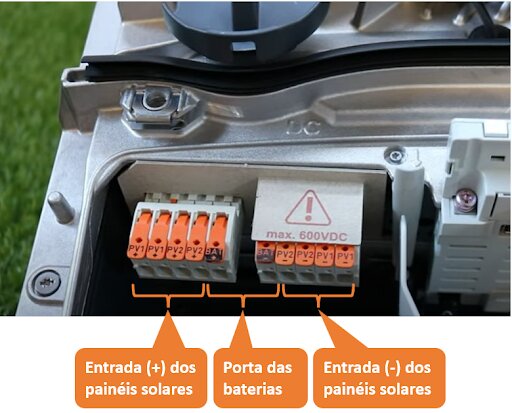

Conclusions
The idea of producing this article began with the aim of definitively answering the following question: what, in fact, is a hybrid solar inverter?
It can be seen that in the market the term “hybrid” is most often associated with inverters for use with batteries and that can operate in two modes: on-grid (grid-tie) and off-grid, fundamental concepts covered in solar energy courses. This is the situation that seems most accepted (and correct, in this author's opinion) for the use of the denomination.
As stated somewhere in this text, more important than knowing the names of the inverters is knowing how they work and what they do. To clarify the differences between each type of inverter (on-grid, off-grid, hybrid), diagrams were presented that illustrate and describe the input and output ports of each type of equipment.
In summary, to finally conclude this article, the hybrid solar inverter is one that has an input for connecting to photovoltaic modules, a port for connecting a battery bank and two AC outputs, one for grid-tie operation and the other for off-grid operation. In some situations (as is the case with the Fronius GEN24 inverter) there may be a single multifunctional AC port, which is capable of operating in grid-tie and off-grid modes.
References
- Single Phase Energy Storage System Installation (SPH6000&GBLI6531) – video tutorial
- SPH 3000-6000 Installation and operation manual (GR-UM-139-A-02)
- Fronius Primo GEN24 PLUS – data sheet
- Fronius Primo GEN24 – instruction manual
- Advanced Webinar: Full Backup of the GEN24 Plus with BYD (AFR) – video tutorial
- Fronius GEN24 Primo Hybrid Solar Inverter | Autosolar – video tutorial


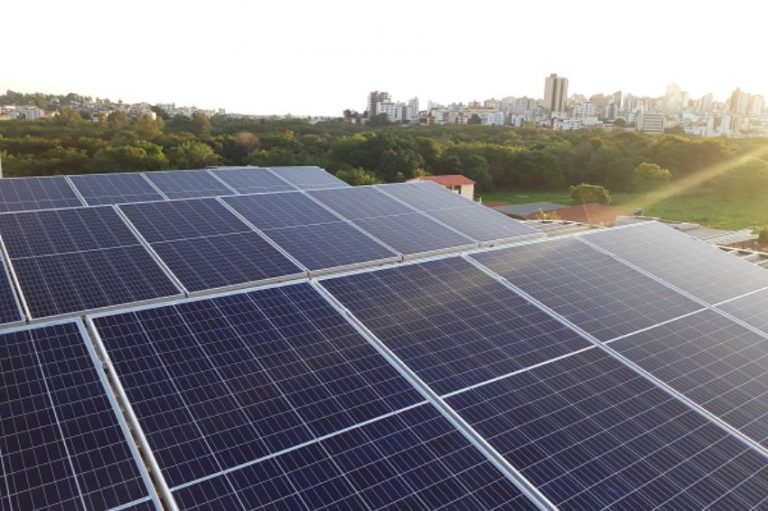















7 Responses
This explanation is wonderful, it clarified details for me that I hadn't picked up in classes on the Energy Engineering course I'm taking! Thank you for your willingness to clarify relevant points regarding photovoltaic system installations.
I have your book!
Marcelo, good afternoon!
Congratulations on the description, I would like to know if instead of installing a battery bank to supply specific loads (figure 4), I can supply it with the existing solar modules themselves, that is, when I lose the reference voltage for parallelism with the dealership, Instead of feeding my specific load (off-grid output of the hybrid) with batteries (bidirectional DC port), I would feed it with the solar modules that would continue with their normal generation. The modules would be plugged into the bi-directional DC port. it's possible?
Hug
Regis
Question: Does the hybrid inverter work even without batteries connected?
Yes!
I'm a layman on the subject, but I have a photovoltaic system in my house, but the company didn't explain much to me about how the system works and after installation they never came here again, not even to find out if I was satisfied. This article of yours was very useful and satisfactory, it was a great incentive for me to understand and install another system in another property. I'll try to study more how it works and install a Fronius Gen24 Hybrid. Because at my house it is already an on-grid fronius. Congratulations on the publication, I look forward to others that help and guide me.
We are happy to have helped you, Silvanio! Discover our Fundamentals in Photovoltaic Solar Energy course, ideal for those who are starting to be part of the market, both consumers and integrators: https://cursos.canalsolar.com.br/curso/fundamentos-de-energia-solar-fotovoltaica-ead/
I have the standard system and I would really like to get this new model so I don't run out of energy every time Energisa cuts for maintenance or makes a thunderclap, that's where the energy goes, so for me this hybrid inverter would be the greatest achievement